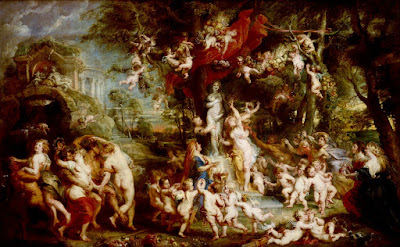A Baroque master between Rome and London: Peter Paul Rubens.
Today is the 440 anniversary of the birth of one of my favourite masters of the past: the great Flemish Baroque painter Peter Paul Rubens, he was one of the most admired and successful artists of the 17th century, his patrons varied from churches to royalty, his art expanded from history to sacredness and from mythology to politics - his legacy, art and works, we will explore in this article.
 |
| The Feast of Venus, c.1635, Kunsthistoriches Museum, Vienna. |
Born on this day in 1577, in Siegen in Westphalia, he was the son of a wealthy lawyer and a well educated wife as well as a brother of six - when he was only 10 years old his father died and the family moved to the larger city of Antwerp in the Spanish Netherlands, where the young artist-to be received training his what what will become his vocation, he served as an apprentice for the local artists' guild in 1598.
His story dramatically changes in 1600, when Rubens travels to Italy and discovers the beauty of late Renaissance masters, especially the Venetian Titian and the refinement of Raphael in Rome. As his genius was starting to appear, he was employed by Vincenzo I Gonzaga, the Duke of Mantua, one of the cultural centres of the time for whom he painted portraits - he was shortly sent by the Duke to Spain, Genoa and Rome, where, under ducal recommendation he started to receive orders from important churches and clients. During his time in Rome, he received the most important commissions, a cycle of frescoes in Santa Croce in Gerusalemme, now sadly lost and that of the high altar of Rome's most renowned Baroque church: the Chiesa Nuova, the altarpiece centred on an older icon of the Virgin and Child surrounded by cheering angels and two side panels with Saint Gregory the Great, Sts. Mauro and Papia and Saint Domitilla with Sts. Nereo and Achilleo - a fascinating triumph of refined, yet unusual for its location, Baroque art in its capital city.
 |
| Rubens' tryptich in the Chiesa Nuova in Rome, c.1607. |
During these years Rubens worked on historical and mythological scenes, a stunning example is the "Wolf and Fox Hunt" (c.1615-21). It is no surprise that he soon became known as the "prince of painters and the painter of princes", after his commissions from Louis XIII of France for a series of 21 canvas representing the triumph of his life and reign with the great Marie de Medici at his side.
 |
| The Birth of Louis XIII, c.1623, Louvre Museum. |
And of course the magnificent "Peace and War" (c.1636) with the famous "Apotheosis of James I" and the "Peaceful Reign of James I" at its centre" in the Banqueting House in London for Charles I of England, the epitome of "Baroqueness", a triumph of the divine role of the English monarchy and probably the greatest work of art commissioned in England after the Reformation and part of the process that triggered the Civil War.
In 1626, Rubens loses his adored wife Isabella and again he travelled, combining diplomatic visits to Spain and England on behalf of the Netherlands (an interesting detail given this was long before the Treaty of Utrecht of 1713) with his artistic career. On his return to the Low Countries, he married his second wife, Helena Fourment, his family "Self-Portrait with Helena and Peter Paul" will be a testament to his life and his newly found happiness with his wife and son.
 |
| Self Portrait with Helena and their Child. |
During these later years the master will produce some of the most celebrated works of this age, such as the idyllic and mythological scenes of the "Judgement of Paris", a representation of the event that led to the Trojan War and the "Garden of Love" a landscape with seminude couples courting each other.
 |
| The Judgement of Paris, c.1637, National Gallery, London. |
At the time of his death, on May 30, 1640, in Antwerp, Rubens was among the most celebrated artists in the whole continent, he left eight children, several assistants, among them Anthony van Dyck, another master to be, he will become another legend of his age. Ruben's skill in complex groupings and composition, the ability to work in grand scales and his great charm as well as his majestic subjects, the way in which he embraced post-Renaissance classicism with Baroque dynamism and lively realism, especially in the curvaceous famous world gave a new meaning to the art of his time. His legacy lived for the ages to come, inspiring artists of the caliber of Rembrandt, Gainsborough and Delacroix.
 |
| The Garden of Love, c.1633, Prado Museum, Madrid. |



Comments
Post a Comment